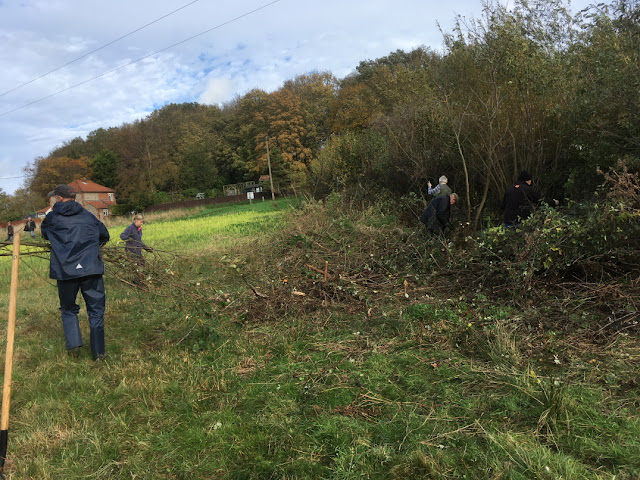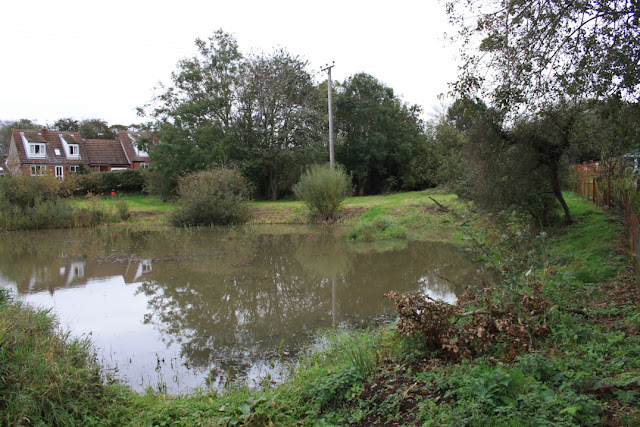With a deadline fast approaching, the Government has acted
and the logjam has cleared for now. I refer not to the B word, but the lifting
of the COVID lockdown, which has enabled us to return to The Common so we can
crack on with cutting the main reedbed before we hit Natural England’s deadline
for completing the task. Accordingly, a call to arms for December’s only
session before Christmas was met with an overwhelming number of volunteers. So
many in fact that in order to maintain the necessary social distancing the two
dozen willing helpers were divided into three groups: one working on the main
reed bed, with the other two working on the area adjacent to the small spur of
the boardwalk leading to Bradfield Road as well as creating spaces for people
to be able to step off the main boardwalk to allow others to pass safely, thus
maintaining a safe space between them. We were joined for the first time by the
very welcome new volunteer Dave: with three Daves in the reed bed team alone,
the chances of the dazed and confused old hands guessing someone’s name correctly were greatly improved!
The more
weather-conscious amongst you will have noticed a certain amount of rain in
recent months, and this has had the effect of making the reedbed wet, very wet
indeed. The whole site must perform a valuable service for Southrepps by
absorbing and holding on to huge quantities of water, but the down side is that
a significant proportion of it is likely to fill the wellies of the unwary
volunteer. So it was with some trepidation that we convened on the second
Sunday of the month to begin the task before us. A couple of days earlier,
three doughty individuals had cut a quantity of reed so there was plenty for us
to get on with straight away.
(Note the impressively purposeful stride of your correspondent in the middle of this group, and it’s not even time for refreshments!)
With two people loading each of the four sheets, two people guiding those sheets being winched to the dumping sites, and two on the winch, all 12 on this team were safely deployed.
As usual, there was plenty of banter, and the physical activity soon warmed up those cold hands and feet. Only at the end was your correspondent and photographer told that Team Leader John had managed to fall over backwards in the mud; something that always raises a cheer and if possible a photo, but sadly this time there is no photographic evidence.
An hour in, and the half-time break arrived. As is the
current rule, we had to provide our own refreshments and to remember to keep
our distance, but the break is always a welcome chance to have a suitably distanced chat with
friends. The reed bed team was joined by the other teams, so it was just as
well that there was now plenty of cleared reed to allow us all to spread out.
We were anxious to ensure that all the reeds that had been cut were shifted to the dumping site at the edge of the area before we finished; leaving them lying there for a month would make them much harder to work with on our return. Therefore, as the clock ran down a hardy trio of volunteers decided to haul a sheet or two themselves, whilst the winch was busy with heavier loads. This blast from the past will have reminded them why the winch was bought, for wet reed is a heavy material.
By the time we finished, the site looked like this.
Much remains to be done before That Deadline arrives, but another three or at most four sessions in the New Year should do it.
With a rare chance for a Sunday morning walk in pleasant weather before more rain was expected, it was good to see quite a few people making their way across the boardwalk. Most people, locals as well as visitors, are generally supportive of the work that we do on behalf of Norfolk Wildlife Trust to maintain this special place. Occasionally a different view is expressed, and this is often the legitimate wish to see nature doing what it does so well without human meddling. However, in the case of this rare valley fen habitat, to leave it un-managed would inevitably result in its fairly rapid conversion to a scrubby woodland, dominated by the alder trees that line the Beck and make it clear they have territorial designs on the whole of the reed bed and the grassy areas which are so precious for hosting such a range of uncommon plants, and of course the specialised animal life that depends on them. The loss of these small fragments would further reduce the biodiversity of this glorious oasis amid deserts of arable monocultures, and is presumably why Natural England monitors this Site of Special Scientific Interest so closely; and why NWT is so pleased with the work we do on its behalf. As has also become clear in recent years, fens, marshes and bogs perform a vital role in carbon capture, even more so than woodland, so by preserving even little patches like this Southrepps is doing a little bit towards mitigating the climate crisis.
Team Leader Julie was in the Bradfield Road team, and
provided the following:
Half the group cleared reed from the Bradfield Road area to allow the snowdrops to flourish in the spring...
The scrub was also cleared back along the Bradfield Road spur of the boardwalk...
The other half of the group tackled some of the scrub encroaching on the boardwalk from Bradfield Road towards the car park...
Anyway, snowdrops are free to emerge:
The area next to the boardwalk on the Bradfield Road spur has been cut back...
And the main boardwalk cut back so people have somewhere to step off to socially distance in this area...
All materials cut back have been stacked for nature to
reuse!
Here is the message of thanks from the Team Leaders:
Dear Volunteers
Today a great group of volunteers braved the cold and damp
to work on the common. Such was the enthusiasm we were able to run two separate
groups. One group tackled the tricky task of clearing the four year old reed
from the reed bed adjacent to the Chadwick Bench. It was very wet and boggy and
there were some cold feet out there.
The second group had a slightly drier area with half of
them clearing the reed on the Bradfield Road site to enable the lovely
snowdrops to flourish in the spring and the other half took up loppers to clear
the scrub back from the boardwalk from Bradfield Road towards the Car Park.
This allows people to be able to step off the boardwalk if required to enable
social distancing and of course means you don't get your hat knocked off by
overhanging branches!
It never ceases to amaze us how much the Volunteers achieve
in two hours on a Sunday morning. So
well done and thank you so much to all of you. Also a big thank you goes out to
ALL of our volunteers for your continued support throughout what has been a
difficult year. We hope that you all stay safe and well and have a lovely
Christmas and New Year.
Regards, Julie, Margaret, John, Kevin, Denise and Sue






















































